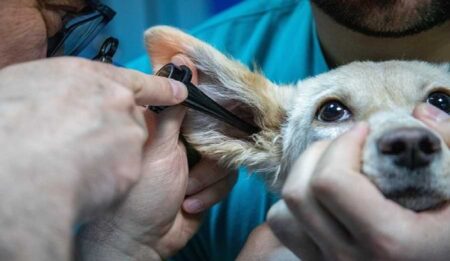When a dog’s front paws point outward rather than parallel to one another, it is said to have east-west feet. The posture, general mobility, and stride of a dog can all be impacted by this aberration. East-west feet can be caused by a variety of circumstances, like as heredity, abnormal puppy growth, or underlying musculoskeletal problems. Finding the underlying cause of this problem and putting the right treatments in place are crucial. Orthopedic equipment like braces or splints, physical therapy, remedial exercises, and in extreme situations, surgery, may be included in this. Furthermore, musculoskeletal health and general mobility can be supported by eating a balanced diet and staying at a healthy weight. Pet owners can assist their dogs in regaining appropriate alignment, mobility, and quality of life by treating the underlying cause of east-west feet and putting tailored treatments into place.
What is The Cause of East-West Feet in Dogs?
Genetic Predisposition
An important factor in the development of dogs’ east-west feet is genetic predisposition. Due to genetic characteristics that alter the limbs’ shape and alignment, some breeds are more susceptible to this illness than others. Breeds that are frequently impacted include German Shepherds, Labrador Retrievers, and Golden Retrievers. The front paws’ tendency to rotate outward can be attributed to either inherited bone deformities or lax joints. Even though genetic aspects are unchangeable, early diagnosis and aggressive management techniques can lessen the condition’s consequences and enhance the dog’s quality of life. To address any associated discomfort or mobility concerns, routine monitoring and action may be required.
Rapid Growth in Puppyhood
Another factor that contributes to the development of east-west feet in dogs is rapid growth during puppyhood. In the first few months of life, puppies’ skeletons grow and develop significantly. If this growth happens too quickly or unevenly, it might result in musculoskeletal anomalies like misplaced feet. Particularly large and giant breeds are prone to fast growth that can surpass the maturation of ligaments and supporting muscles, leading to misaligned limbs. In order to promote healthy skeletal development and lower the risk of orthopedic problems like east-west feet, proper nutrition, moderate exercise, and growth rate monitoring are crucial during the puppy stage. Any irregularities can be addressed and long-term consequences can be avoided with early intervention.
Muscle Imbalances
Dogs’ east-west feet might develop as a result of muscle imbalances. A person’s limb alignment and function can be impacted by the strength or development of specific muscles, which can cause irregularities in gait and foot placement. The feet may point outward as a result of the limbs being pulled out of alignment by weakness or tension in particular muscle groups. To make matters worse, muscle imbalances can also be caused by overuse, injury, or inadequate training. For dogs with east-west feet, physical therapy, focused exercises, and stretching regimens can help resolve muscle imbalances, enhance general musculoskeletal health, and encourage normal limb alignment. Effective management of this illness requires ongoing veterinary evaluations and individualized rehabilitation plans for each dog.
Joint Problems
In dogs, east-west foot development might be attributed to joint issues such as elbow or hip dysplasia. These orthopedic disorders impact the morphology and functionality of the joints, resulting in aberrant gait patterns and alignment of the limbs. Dysplastic elbows or hips can cause pain, instability, and limited range of motion in dogs, which can lead to compensating alterations in posture and gait. These compensations have the potential to cause musculoskeletal anomalies, such as east-west feet, over time. In order to improve joint function and reduce discomfort, joint disorders are usually managed using a combination of medical treatments, such as medication and vitamins, and rehabilitative therapies, such physical therapy and hydrotherapy. Dogs with east-west foot must have their underlying joint problems identified and treated in order to maintain and improve their
Injuries
Dogs may also have east-west feet as a result of injuries. Traumatic injuries, such fractures or torn ligaments, can cause anomalies in gait and foot placement by upsetting the usual alignment and function of the limbs. Muscle imbalances and changed limb alignment over time can also be caused by soft tissue damage from overexertion or strenuous activity, or by repeated strain injuries. Dogs with injuries may adjust by favoring one limb or changing their gait, which may cause further alterations in the way their feet are positioned. To correct underlying problems and avoid long-term complications like east-west feet, injuries must be properly diagnosed and treated with rest, rehabilitation exercises, and veterinarian care.
Obesity
Dogs’ east-west foot development may be influenced by obesity. Gaining too much weight puts strain on the muscles, ligaments, and joints, which can cause musculoskeletal problems and misaligned limbs. Dogs that are overweight may have impaired muscle tone, decreased mobility, and greater limb strain, which can lead to irregularities in their gait and incorrect foot placement. Furthermore, obesity can aggravate orthopedic disorders like hip dysplasia or arthritis, which can exacerbate east-west feet. Obesity is also linked to inflammation and degenerative changes in the joints. Treating and treating obesity-related orthopedic problems in dogs, such as east-west feet, requires consistent exercise, healthy eating, and weight control. A veterinarian or veterinary nutritionist consultation can offer advice on reaching and keeping a healthy weight for
Poor Nutrition
Dogs that have east-west feet may have this condition as a result of poor diet. Deficits in vital nutrients, including vitamins, minerals, and protein, can arise from inadequate or unbalanced diets. These nutrients are important for the formation of healthy bones and muscles. Puppies who do not receive enough nutrients may grow slowly or abnormally, which can cause musculoskeletal problems like east-west feet and other bone anomalies. Furthermore, deficits or excesses of specific nutrients might interfere with the metabolism and development of bone, raising the possibility of orthopedic issues. East-west feet and other developmental defects can be prevented and good skeletal health maintained by feeding your dog a diet rich in nutrients and adjusted according to his age, size, and breed. Visiting a vet or veterinary nutritionist can help guarantee that your dog gets
Long Toenails
In dogs, long toenails may have an indirect role in the development of east-west feet. Overly long toenails can affect how a dog balances their weight on its paws, which can cause posture and movement abnormalities. This changed weight distribution throughout time may have an impact on limb alignment and perhaps exacerbate conditions like east-west feet. Long toenails can also hurt and interfere with a dog’s ability to walk correctly, which exacerbates problems in their gait. Maintaining optimal paw health and avoiding issues related to lengthy toenails need routine nail clipping. Maintaining the proper length of your dog’s nails will encourage a healthy gait and lower their chance of developing orthopedic problems like east-west feet.
Signs Your Dog Has East-West Feet
Veterinary Exam
In order to identify and treat the underlying causes of dogs’ east-west feet, a veterinarian examination is essential. A comprehensive physical examination of your dog’s musculoskeletal system will be performed by the veterinarian during the examination. This evaluation will include measurements of muscle tone, joint mobility, and limb alignment. Additionally, in order to assess the underlying bone structure and find any anomalies or joint problems causing the east-west foot, they might perform X-rays or other diagnostic imaging procedures.
The vet will also ask about your dog’s nutrition, exercise regimen, medical history, and any changes in behavior or mobility. By having this information, the doctor can better assess the circumstances behind your dog’s illness and provide a personalized treatment plan for them. Depending on the severity and underlying cause of the east-west foot, the veterinarian will propose treatment options based on the results of the veterinary exam. These choices may include physical therapy, remedial exercises, orthopedic devices, medication, or surgical intervention. It will be essential to schedule routine follow-up examinations to track your dog’s development and modify the treatment plan as necessary..
Diagnostic Imaging
X-rays and other diagnostic imaging are crucial for determining the underlying reasons of east-west feet in dogs. X-rays give veterinarians precise pictures of the bones and joints, enabling them to evaluate alignment, structure, and any anomalies. This imaging modality highlights skeletal problems that contribute to the illness, such as arthritis, fractures, or joint laxity. Furthermore, magnetic resonance imaging (MRI) or computed tomography (CT) scans might provide more information on soft tissue involvement. Veterinarians may precisely identify the degree of musculoskeletal problems and create specialized treatment programs to address east-west foot, thereby enhancing the mobility and quality of life of their patients. This is made possible through the use of diagnostic imaging.
Bloodwork
Bloodwork can provide important details about a dog’s general health and indicate any underlying medical diseases that may exacerbate musculoskeletal problems, even though it may not be able to diagnose east-west feet in dogs. Blood tests can evaluate factors that may impact the health of the bones and joints, such as nutritional deficiencies, metabolic problems, and systemic diseases. These parameters include complete blood count (CBC), serum chemistry, and thyroid function. Blood testing can also look for indicators of infection or inflammation, which could point to underlying orthopedic problems. Bloodwork is an essential part of the diagnostic workup to guarantee that the dog receives thorough care, even though it may not be able to diagnose east-west feet on its own.
Specialist Consults
Dogs with east-west foot alignment may benefit from specialized consultations with veterinary orthopedic surgeons or veterinary rehabilitation specialists. These experts are highly skilled in the diagnosis and treatment of musculoskeletal disorders in animals. A comprehensive assessment of the dog’s limbs, including a physical examination, gait analysis, and maybe diagnostic imaging like X-rays or CT scans, will be carried out by the veterinarian during a specialist consult. They might offer a customized treatment plan based on their findings, which might involve surgery, physical therapy, orthopedic equipment, treatment, or other forms of rehabilitation. Expert consultations guarantee that the dog gets the best possible treatment and knowledge for treating east-west feet and fostering maximum mobility and quality of life
Genetic Testing
If there are any suspected inherited causes of east-west feet in dogs, genetic testing might be taken into consideration. Genetic testing can detect particular gene mutations or indicators linked to musculoskeletal disorders, such joint laxity or skeletal deformities, by examining the dog’s DNA. In order to lower the occurrence of east-west feet in subsequent generations, this information can assist validate a hereditary predisposition to the condition and direct breeding techniques. Furthermore, genetic testing can offer insightful information for creating management and treatment plans that are specifically suited to each dog’s unique genetic makeup. Genetic testing can be helpful for vets and breeders who want to learn more about the underlying genetic elements that contribute to east-west foot, even if it might not be required in every case.
Non-Surgical Treatment Options for East West Feet in Dogs
Weight Management
For dogs with east-west feet, weight control is essential because being overweight can worsen musculoskeletal problems and cause irregularities in gait. Sustaining a healthy weight eases the strain on joints, enables maximum mobility, and improves general health. A balanced diet that is adapted to the dog’s energy and nutritional demands is crucial for healthy weight management. This may be providing a premium, portion-controlled diet and refraining from giving them too many goodies or leftovers from the meal. Frequent exercise is beneficial for managing weight and maintaining general health, but it should be customized for the dog’s condition and restrictions to avoid exacerbating limb strain. Dogs with east-west feet can benefit from help on creating a customized weight control plan by speaking with a veterinarian or veterinary nutritionist.
Joint Supplements
Dogs with east-west feet may benefit from joint supplements since they can promote joint health and lower the chance of musculoskeletal problems related to the disease. These supplements usually include components that are known to maintain cartilage health, reduce inflammation, and improve joint function, such as glucosamine, chondroitin sulfate, and omega-3 fatty acids. Joint supplements assist reduce pain, increase range of motion, and decrease the advancement of degenerative joint illnesses like arthritis by giving the joints more support. But before beginning any supplements, it’s crucial to speak with a veterinarian because they can provide advice on the best formulation and dose to suit the individual requirements of your dog. Joint supplements should also be a part of a complete management plan for dogs with east-west feet, utilized in concert with other therapy approaches. Top of Form
Targeted Physiotherapy
Dogs with east-west feet may benefit greatly from targeted physiotherapy, which focuses on enhancing muscle strength, flexibility, and general mobility to address musculoskeletal problems and irregularities of gait that are related to the condition. Therapeutic exercises, manual treatment methods, hydrotherapy, and therapeutic modalities like ultrasound or electrical stimulation are a few examples of physiotherapy interventions. The ultimate goal of these focused therapies is to promote improved limb alignment and function by strengthening supporting muscles, enhancing joint range of motion, and correcting irregularities in gait. In order to effectively meet treatment goals, a skilled veterinary physiotherapist can create a customized physiotherapy program based on the needs and health of each particular dog. Dogs with east-west feet can benefit from regular physiotherapy treatments in addition to at-home exercises and management techniques to increase their mobility, comfort, and quality of life.
Orthopedic Braces or Splints
For dogs with east-west feet, the treatment plan may include the use of orthopedic braces or splints to promote appropriate limb alignment and offer external support. By stabilizing the afflicted limbs, these devices can lessen joint tension and enhance mobility and function. Custom-made to fit the dog’s limbs, orthopedic braces or splints are intended to address certain biomechanical problems related to east-west feet. To get the best results for the dog’s musculoskeletal health, they are usually used in conjunction with other treatment techniques, such as physiotherapy or weight management. It could be essential to conduct routine checks and modifications to guarantee appropriate fit and efficiency.
Pain Medication
Dogs with east-west feet may be prescribed pain medication to relieve discomfort related to musculoskeletal conditions, such as arthritis or inflammation of the joints. NSAIDs, or nonsteroidal anti-inflammatory medicines, are frequently used to lessen pain and inflammation, enhancing the general comfort and movement of dogs. A veterinarian should prescribe and oversee the use of these drugs because they may have unintended consequences or interact with other treatments. When the dog is taking painkillers, it’s critical to carefully follow the veterinarian’s dose guidelines and keep an eye out for any negative responses. In order to maintain the wellbeing and quality of life of dogs with east-west feet, pain treatment is crucial.
Alternative Therapies
Alternative therapies can complement traditional treatments for dogs with east-west feet, offering additional avenues for pain relief, mobility improvement, and overall well-being. These therapies may include:
Acupuncture: This traditional Chinese medicine uses tiny needles inserted into certain body sites to relieve pain, lower inflammation, and accelerate recovery.
Chiropractic Care: To realign the spine and joints and improve mobility and relieve pain related to musculoskeletal problems, veterinary chiropractors employ manual adjustments.
Massage Therapy: For dogs with east-west foot alignment, massage therapy can ease tense muscles, enhance blood flow, and lessen soreness and stiffness.
Laser Therapy: In order to aid in the healing and pain alleviation of injured limbs, low-level laser therapy stimulates cellular repair and lowers inflammation.
Hydrotherapy: Low-impact workouts like swimming or underwater treadmills help improve muscles and lessen joint tension.
Herbal Remedies: While their effectiveness should be assessed under veterinary supervision, some herbs and supplements may have anti-inflammatory or pain-relieving qualities.
Alternative therapies can provide dogs with east-west feet with comprehensive care by treating both the physical and emotional components of their illness when used in conjunction with traditional treatments. To guarantee safe and efficient care, speak with a licensed veterinarian with experience in complementary therapies.
Surgical Interventions to Fix East West Feet
Bone Realignment
When conservative measures have failed to significantly improve a dog’s east-west foot condition, bone realignment may be a viable option. The goal of this surgical procedure is to realign the misaligned bones, usually by relocating and cutting them to a more normal orientation. Osteotomy, or cutting the bone, or corrective osteotomy, or reshaping the bone, may be part of the operation. Board-certified veterinary orthopedic surgeons are frequently the ones who perform bone realignment surgery, which necessitates meticulous preoperative assessment and subsequent care. Although it has the potential to greatly improve limb function and mobility, it is not without danger and necessitates careful rehabilitation to guarantee positive results.
Tendon Repositioning
Tendon repositioning is a surgical method used to treat musculoskeletal problems in dogs with east-west foot alignment by realigning the damaged tendons. Tendon repositioning or lengthening is a common technique used by veterinary surgeons to enhance limb alignment and function. Tendon repositioning helps restore normal joint mechanics by resolving imbalances in muscle tension, which relieves limb strain and improves gait and mobility. A satisfactory outcome depends on both surgical rehabilitation and preoperative assessment. Although tendon repositioning has been shown to be beneficial in some situations, not all dogs will benefit from treatment, and A licensed veterinary specialist should be consulted before making any surgical decisions.
Joint Stabilization
Joint stabilization is a treatment approach aimed at improving the stability and function of the joints affected by east-west feet in dogs. This may involve various surgical techniques or non-surgical methods to strengthen the supporting structures around the joint and minimize abnormal movement. Surgical options may include procedures such as joint capsule imbrication, where the joint capsule is tightened to reduce excessive movement, or the placement of implants or prosthetics to provide additional support. Non-surgical approaches may include physical therapy, targeted exercises, and the use of orthotic devices or braces to stabilize the joint and improve alignment. Joint stabilization aims to reduce pain, improve mobility, and prevent further deterioration of the affected joints in dogs with east-west feet.
Growth Plate Stapling
A surgical technique called growth plate stapling, sometimes referred to as physicals stapling, is used to correct limb alignment and alter bone growth in young dogs with skeletal abnormalities such east-west feet. Metal screws or staples are used in the process to cross the physed, or growth plates, close to the ends of the bones. This allows the other side of the bone to grow and rectify the abnormality by momentarily stopping the growth on the affected side. Puppies with open growth plates usually have growth plate stapling, which requires close observation as the bones develop and grow. By lowering the severity of east-west feet and enhancing the dog’s quality of life, this surgery seeks to improve limb alignment and function.
External Fixation Devices
Orthopedic devices called external fixation devices help dogs with disorders like east-west feet by stabilizing fractures, correcting deformities, and encouraging bone repair. These devices are made up of external frames, screws, wires, or pins that are fastened to the body’s exterior bones. External fixation devices help straighten bones, preserve normal alignment during healing, and prevent additional deformity by offering stability and support to the damaged limbs. External fixation devices can be utilized as part of a comprehensive treatment strategy for east-west foot in order to stabilize the bones throughout the healing process or to support corrective surgical treatments. To guarantee the equipment operates correctly and is aligned, regular inspections and modifications are required.
Conclusion
Dogs with east-west feet may have difficulties with mobility and quality of life; nevertheless, many dogs can significantly improve with the right diagnosis and care. Developing an effective management plan requires an understanding of the underlying reasons, which may include musculoskeletal difficulties, rapid growth, or hereditary susceptibility. Conservative measures including weight control, physical therapy, and painkillers may be used in addition to surgical procedures like tendon repositioning or bone realignment. Enhancing limb function and promoting healing can also be accomplished with the use of external fixation devices and alternative therapies. Dogs with east-west feet can benefit from comprehensive treatment plans that are customized to meet their specific needs and can optimize results. This can be achieved through close collaboration with veterinary professionals.
FAQS
What do dogs’ east-west feet mean?
A: conformational flaw in dogs where the front paws point outward rather than parallel is known as “east-west feet.” The dog’s gait and general movement may be impacted by this.
What causes dogs to have east-west feet?
A: Hereditary factors, malformed growth during puppyhood, muscle imbalances, or injuries can all contribute to east-west feet. Usually there isn’t just one cause, but rather a confluence of variables
.
Can a dog’s east-west foot alignment be corrected?
A: Yes, dogs’ east-west feet may frequently be improved with the right care and assistance. Physical therapy, muscular-strengthening exercises, and in certain situations, surgical correction may be necessary for this.
Is it necessary to treat dogs’ east-west feet?
A: It is crucial to treat east-west feet.








